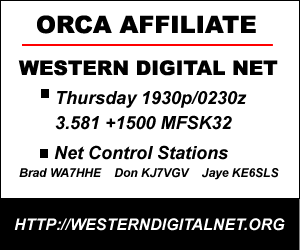MISSION
Mission Statement
The ORCA DIGITAL NET is dedicated to training digital Amateur radio operators and practicing the skills required for efficient digital communications. Digital radio skills are built on ARRL Directed Net protocols, basic computer knowledge, typing skills, and familiarity with FLDIGI NBEMS applications. ORCA DIGITAL NET is prepared to support community emergency services in times of need. The net is not limited to a particular geographic area, but seeks to connect regions with mutual interest in practice, sharing information, and mutual aid.
History
The ORCA DIGITAL NET (HF) is an outgrowth of the ORCA EMERGENCY NET (VHF), founded in January of 2013 to provide digital communications training and emergency communications on VHF simplex in Curry County, Oregon and Del Norte County, California. Introducing new Amateur Ops to acoustically coupled digital communications was it’s primary focus. Local interest in digital communications was keen and the net grew rapidly. VHF simplex became a limitation when Humboldt County Ops joined the net. 100 miles is a long haul for reliable VHF communications. Some days, communications were perfect; on other days, non-existent. The organizers were of two minds regarding net development. Some wanted to retain focus on acoustic based digital communications for new operators. Others wanted to develop and practice digital-traffic-handling tactics on HF. The original VHF simplex net is still active in Del Norte County, CA. The ORCA DIGITAL NET has expanded on HF to serve western United States. ORCA DIGITAL NET soon realized they could not support emergency operations without seasoned digital Operators. Training and practice became the primary focus. In the event of an emergency, the ORCA DIGITAL NET is ready to assist community emergency services with digital communications.
TRUTH is often wrapped in Familiar Sayings …
‘We do not rise to the level of our expectations. We fall to the level of our training.’
Greek poet Archilochus’s (680-645/BC)
‘Under pressure, you don’t rise to the occasion, you fall to your level of training.’
A modern rephrasing widely attributed to a US Navy Seal who believes the success of an operation is determined by how well you prepared. Train Smart. Train Often. Train Hard.





